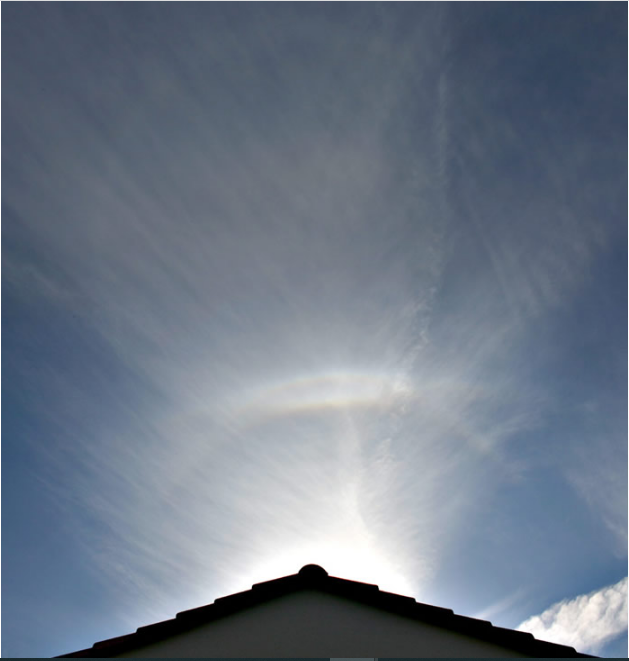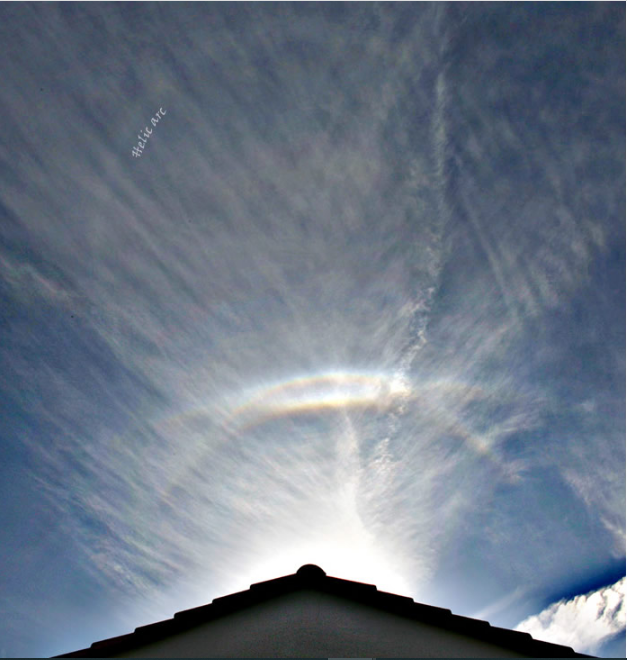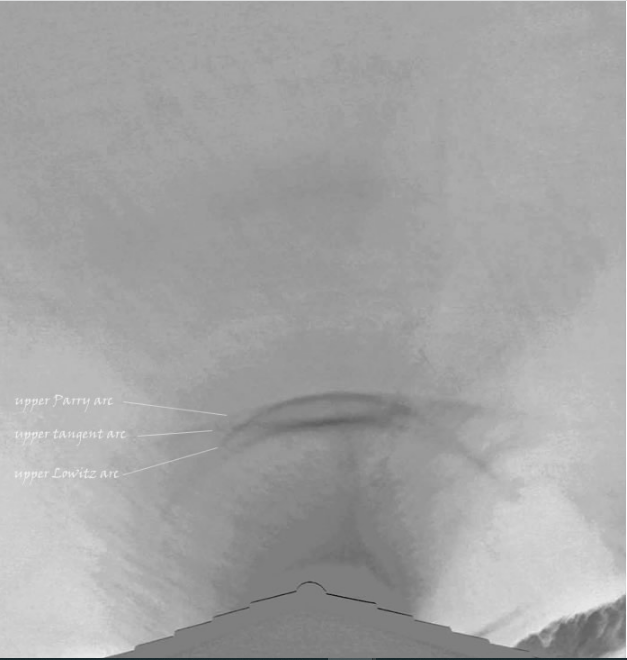OPOD - Helic & Lowitz Arcs, France
OPOD - Helic & Lowitz Arcs, France: A Rare Atmospheric Phenomenon
Have you ever witnessed a mesmerizing atmospheric optical display? Cyrille Baudouin, a keen observer of the sky, captured a truly extraordinary sight at La Bruffière in western France. In his photographs, he documented the presence of both a helic arc and an upper Lowitz arc, two rare and fascinating atmospheric phenomena that are not commonly observed.
The Helic Arc: A Faint White Oval Halo
High above the sun, there is a faint white oval halo known as the helic arc. This particular halo is rarely seen and is often overlooked by casual skywatchers. However, with the aid of enhancement techniques such as unsharp masking, the helic arc becomes more visible. By increasing contrast and sharpness, unsharp masking can reveal intricate details of this elusive phenomenon.
The Upper Lowitz Arc: A Rarity Between Tangent and Parry Arcs
In close proximity to the sun, nestled between the upper tangent and Parry arcs, lies another exceptional optical phenomenon - the upper Lowitz arc. This arc is not commonly observed and adds to the already captivating display in the sky. Its presence further highlights the complexity and diversity of atmospheric optics.
Enhancing the Visibility: Unsharp Masking and Colour Subtraction
To enhance the visibility of these ethereal halos and capture their beauty in photographs, various techniques can be employed. One such technique is unsharp masking, which allows for an increased visibility of all halos. However, it is important to note that unsharp masking may introduce artifacts that can be mistaken for halos, such as sharpened cloud streaks. Careful observation and analysis are necessary to differentiate between genuine halos and artifacts.
Another highly effective technique, introduced by Nicolas Rossetto, is colour subtraction. By subtracting the blue and red image channels, coloured halos are accentuated, standing out sharply against the background. This technique renders white halos, including the helic arc, parhelic circle, and 120° parhelia, less visible. Through colour subtraction, the intricate details of these captivating phenomena can be brought to the forefront, allowing for a more immersive viewing experience.
Cyrille Baudouin's Captivating Images
The captivating images captured by Cyrille Baudouin serve as a testament to the beauty and complexity of atmospheric optics. Through his lens, he has provided us with a glimpse into the rare occurrence of both the helic arc and upper Lowitz arc. These images not only showcase the unique atmospheric conditions in La Bruffière, France but also serve as a reminder of the awe-inspiring wonders that can be found in our own skies.
Conclusion
The observation of atmospheric optical phenomena, such as the helic arc and upper Lowitz arc, offers a captivating and thought-provoking experience. These rare occurrences remind us of the intricate nature of our atmosphere and the wonders that can be found above us. Through the use of enhancement techniques like unsharp masking and colour subtraction, we can further explore and appreciate the intricate details of these phenomena. Cyrille Baudouin's photographs serve as a visual testament to the beauty and complexity of atmospheric optics, providing us with a window into the extraordinary sights that can be witnessed in our own skies. So, next time you find yourself gazing up at the heavens, keep an eye out for these elusive atmospheric treasures.

Normal Image

Unsharp Masking

Colours Subtraction
Helic & Lowitz Arcs
Cyrille Baudouin captured this unusual sight at La Bruffière in western France.
High above the sun is a faint white oval halo, a rarely observed part of a helic (old name heliac) arc,
Closer to the sun between the upper tangent and Parry arcs is another rarity - an upper Lowitz arc.
Mouse over the buttons for enhancement options. Traditional unsharp masking can increase the visibility of all halos. Here it shows up the helic arc well. Unfortunately, unsharp masking can also introduce artifacts that can be mistaken for halos. Sharpened cloud streaks can also look like halos.
Colour subtraction is a highly effective technique introduced by Nicolas Rossetto. Blue and red image channels are subtracted with the result that coloured halos stand out sharply. White halos like the helic ac, parhelic circle and 120° parhelia are rendered less visible as evidenced here.
Images ©Cyrille Baudouin, shown with permission.
Note: this article has been automatically converted from the old site and may not appear as intended. You can find the original article here.
Reference Atmospheric Optics
If you use any of the definitions, information, or data presented on Atmospheric Optics, please copy the link or reference below to properly credit us as the reference source. Thank you!
-
<a href="https://atoptics.co.uk/blog/opod-helic-lowitz-arcs-france/">OPOD - Helic & Lowitz Arcs, France</a>
-
"OPOD - Helic & Lowitz Arcs, France". Atmospheric Optics. Accessed on April 18, 2024. https://atoptics.co.uk/blog/opod-helic-lowitz-arcs-france/.
-
"OPOD - Helic & Lowitz Arcs, France". Atmospheric Optics, https://atoptics.co.uk/blog/opod-helic-lowitz-arcs-france/. Accessed 18 April, 2024
-
OPOD - Helic & Lowitz Arcs, France. Atmospheric Optics. Retrieved from https://atoptics.co.uk/blog/opod-helic-lowitz-arcs-france/.